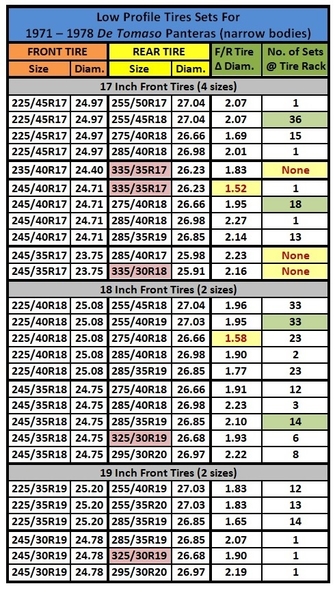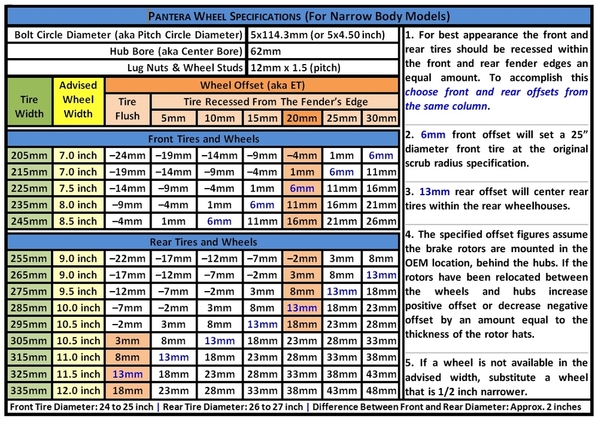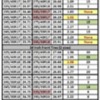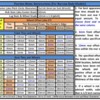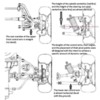D-
Welcome aboard. Sympathy for the loss of your father.
Tire Diameter and Front to Rear Δ
Like any car the Pantera's front and rear wheel wells will only look “GOOD” with front and rear tires that are within a small range of diameters. One very unusual aspect of the Pantera is that the front fender openings were deigned for tires approximately 2 inches smaller in diameter than the Pantera's rear tires.
A front tire 25 inches in diameter fills the front fender opening quite fully, whereas a front tire smaller than 24 inches in diameter begins to look proportionally too small for the fender opening. Therefore front tire diameter should remain within the range of 24” to 25”.
A rear tire 27 inches in diameter fills the rear fender opening quite fully, whereas a rear tire smaller than 26 inches in diameter begins to look proportionally too small for the rear fender opening. Therefore rear tire diameter should remain within the range of 26” to 27”.
In terms of appearance the tire set should use front and rear tires with diameters that fill the front and rear fender openings the same amount, i.e. the difference in the diameter of the front and rear tires (the "Δ") should be about 2 inches. Setting-up the chassis around a tire set like this will also result in the chassis geometry being set-up as it was designed.
This difference in tire diameter (the Δ) is the most basic aspect to get right in terms of appearance AND chassis set-up, which is why I've mentioned it first thing, right up front. You'd be surprised how often this has been gotten wrong.
Ride Height
Using tires on the small end of acceptable diameters (24" front, 26" rear) will only lower the car 1/2 inch compared to tires that are on the large end of acceptable diameters (25" front and 27" rear). Small diameter tires don't lower the car tremendously. A lowered ride height is more a function of chassis set-up.
North American Panteras were equipped with spacers between the springs and shocks to raise their ride height about 1". The spacers were omitted from the European models. In other words, the European "standard body" Panteras sit 1" lower to the ground than their North American cousins. If a reader's US Pantera still has those spacers installed, then the first step towards achieving a lower "stance" is to remove the spacers. Lowering the Pantera improves appearance AND handling.
However, rather than rely on the ride height built into the factory shocks and springs, ride height and stance can be "dialed-in" much better utilizing modern gas shocks that feature the ability to adjust spring pre-load. Shocks with adjustable spring pre-load make it possible to fine tune the front and rear ride height individually. I would add my voice to those of David and Devin who both already hinted at this:
quote:Originally posted by David_Nunn:
... with a good spring/shock package, the "stance" of the car no longer depends upon tire diameters.
quote:Originally posted by Garvino:
... came to the conclusion that I wanted the ability to adjust the ride height of my car to my specific liking. I ended up buying a new set of Koni’s with Hyperco springs and am glad that I did.
The compliance of modern gas shocks complements the shorter/stiffer sidewalls of lower profile tires more so than the OEM shocks. Therefore everyone should consider installation of modern gas shocks a pre-requisite for the installation low-profile tires, regardless of wether or not they plan to change their Pantera's ride height.
Setting-Up a Pantera Chassis
Whereas many automobiles are “lowered” by their owners to improve handling, the Pantera was originally designed to be about as “low as you can go” right off the showroom floor (before Ford raised the Pantera's ride height by 1 inch). If you set-up your Pantera to ride as it was originally intended by its famous designer (Gian Paolo Dallara), I don't think you'll be disappointed.
In preparation the fuel tank should be half full with fuel, the driver & passenger should be sitting in the seats, and the tires should be filled to the appropriate air pressure.
If the shocks have pre-load adjustment (its optional with the steel body Koni shocks) the chassis needs to be leveled; i.e. the frame rails that run below the doors should be equal distant to the ground front to back, and side to side. The minimum ride height sets the rear lower control arms level with the ground. To achieve that ride height adjust the rear springs first, then level the chassis by adjusting the front springs.
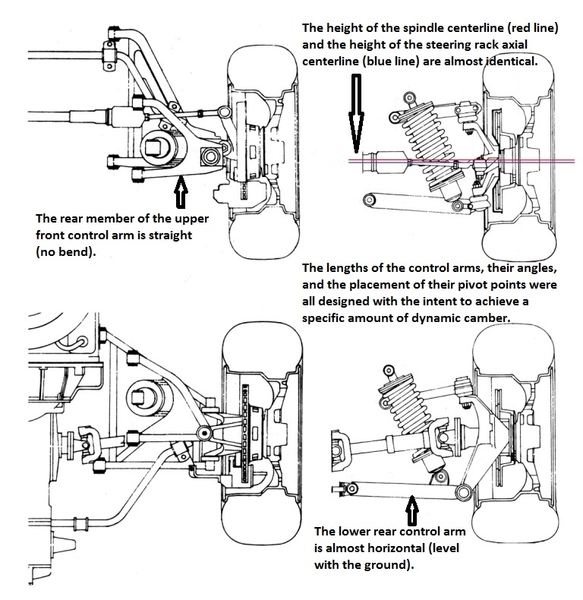
At this point the car is about as low as its going to get. My Pantera is set-up this way, and a racing style floor jack barely fits under the jacking points. The car bottoms out on large high speed bumps and dips, and the middle of the car scrapes certain driveways and speed bumps. I personally wouldn't want the ride height of my Pantera to be any lower than this. My Pantera has spring rates of 450 lbs front and 550 lbs rear. If the springs were softer it would bottom out more often.
If your Pantera is equipped with a front/rear tire combination in which the front tires are 24 to 25 inches diameter, the rear tires are 26 to 27 inches diameter, and the rear tires are about 2 inches greater in diameter than the front tires, then after adjusting the front and rear ride height in this manner the tires should be centered in the fender openings, and the gaps between the tires and fender openings should be fairly equal front to rear. This provides best appearance and best chassis set-up.
Upgrading to Modern Wheels and Tires
quote:
Originally posted by Clockwork:
... I've basically given up on 15" tires and have decided to move on to Campi Clones …
If you're going to go out and just purchase a set of Campy clone wheels with 17x8 front dimensions and 17x11 or 18x12 rear dimensions … the tire choices are:
(1) Front: 245/35ZR17 (23.75 diam.) Rear: 285/40ZR17 (25.98 diam.) 2.23 Δ
(2) Front: 235/40ZR17 (24.40 diam.) Rear: 335/35ZR17 (26.23 diam.) 1.83 Δ
(3) Front: 245/35ZR17 (23.75 diam.) Rear: 335/30ZR18 (25.91 diam.) 2.16 Δ
These are what I call "small diameter" tire sets, on par with the Pirelli P7 that were installed on the narrow bodies beginning 1977 (225/50VR15 and 285/50VR15). Some vendors choose to use 225/45R17 front tires which are 24.97 inches diameter. That is not a "small diameter" front tire, and tires in that size are not good front tires to complement the usual rear tires due to the resulting difference in front to rear diameters (i.e. the Δ).
Tire availability (according to The Tire Rack, 2019):
235/40ZR17: (6) Dunlop, Falken, Sumitomo, Toyo (Proxes R1R), Yokohama (x2)
245/35ZR17: (1) Toyo (Proxes R1R)
285/40ZR17: (2) Continental, Pirelli P Zero
335/35ZR17: (2) Michelin Pilot Sport, Pirelli P Zero
335/30ZR18: (4) BF Goodrich G-Force (x2), Pirelli P Zero (x2)
Unfortunately according to The Tire Rack (2019) there are no "sets" available using the same make and model of tire for the front and rear. This is a dismal situation. Installing the ultra-wide 17 inch rear tire requires a compromise in wheel width and offset, but the 18 inch rear tire does not; therefore the 18 inch rear tire may be a better choice. Availability of both of the 17 inch rear tires seems to be off and on as well.
You can purchase wheels sized for tire sets that will improve the tire availability situation. Would you care to take a brief excursion down the rabbit hole with me?
The 335/35ZR17 rear tire has been around since 1990, the 335/30ZR18 tire has been around since 1995. The tire sets listed above AREN"T REALLY MODERN.
Appearance is always high on everyone's criteria when it comes to upgrading tires and/or wheels. But another possible criteria for selecting tires or wheels is the availability of front/rear tire sets. Acquiring tires in sizes which aren't supported by the tire industry can be frustrating and expensive. Life is frustrating enough without spending a lot of money on a wheel set which adds to life's frustration. Spending a sizeable amount of money on something that adds to life's frustration is tantamount to shooting yourself in the foot.
De Tomaso owners considering the purchase of aftermarket wheels in the year 2012 2019 are doing so for one to three reasons:
• Because they are frustrated with the availability of 15", 16", or 17" tires. They need wheels designed for tire sets in sizes that are available from several tire manufacturers now and shall continue to be available into the future.
• Because they want to modernize the appearance of their Pantera.
• Because they want to improve the performance of their Pantera, which includes equipping it with the best performing modern tires they can afford.
If you're going to spend a substantial amount of money on a new set of wheels, it makes sense to purchase the wheels for a tire set that shall be available for the next 15 to 20 years, and for which more than one make and model of tire is available. I don't need to tell you that the auto industry is currently installing 18", 19", and 20" wheels on new high performance production automobiles. Aspect ratios are 40 on the tall side, 35 and 30 predominantly, and even as low as 25 on the short side. A 4 inch sidewall is a tall one in today's world; even SUVs have 4" sidewalls. In some cases sidewall height has dropped a bit below 3 inches.
Based upon the availability of "tire sets" a new set of wheels TODAY (2012 2019) should incorporate 17" or 18" front tires and 18" or 19" rear tires. The choices in 18" rear tires for the Pantera are not bountiful. But they are better than the choices in 15", 16" and 17" tires.
Tire Width ... How Wide Is Wide?
245mm is the widest front tire that "can" be installed without rubbing issues (if excessive offset is avoided). A tire in that width is therefore capable of offering the best performance in terms of response to driver input, cornering grip, and braking. The 245/40R17 and 245/35R18 are the proper diameters for the front of the Pantera. The only drawback I am aware of in comparison to a narrower tire shall be increased steering effort during parking maneuvers. I don't purchase tires based on their parking lot performance.
The last Pantera (i.e. the Pantera Si) was introduced in 1990 equipped with 235mm front tires and 335mm rear tires on 17 inch wheels, that choice in tires was no doubt influenced by the introduction of the 335/35ZR17 tire in 1990. But De Tomaso's last sports car, the Guara, was introduced 3 years later (1993) equipped with 245mm front tires and 285mm rear tires on 18 inch wheels. This was a cutting edge tire set when the Guara was introduced in 1993, it has become a very common tire set for sports car since then.
As an example, the German engineered 2017 Audi R8 is propelled by a naturally aspirated 5.2 liter V10 engine rated at 540 BHP and 398 ft./lbs. torque. Its curb weight is 3649 pounds; that weight is distributed 42% on the front tires and 58% on the rear tires. It accelerates from a standstill to 60 MPH in 3.5 seconds. It circles the skid pad at 1.00 G; and it stops from 70 MPH in 153 feet. It is equipped with 245/35R19 front tires and 295/35R19 rear tires as standard equipment. I am confident that a tire complement similar to this is well suited for most Panteras.

Future Tire Availability:
These two internet sites help in judging the availability of tires, they both allow you to perform a search based on tire size. One very beneficial feature offered by both web sites, they allow you to search by size for "sets" of tires wherein the front tires and rear tires are a different size.
Tire Rack.com/
On Line Tires.com/
The web site linked below lists the OEM applications of the various tire sizes, and the years. Obviously more applications, and/or more recent usage will indicate good prospects for future availability.
Size My Tires
Possible Tire Sets
Once you've selected a set of tires you have to acquire a set of wheels to mount them on.
Wheel Width
Unlike the average car in which all 4 tires are the same size, and all 4 wheels are identical (same width and offset) the Pantera uses front and rear tires differing in width and diameter by a significant amount, and requires wheels of different widths and offsets for front and rear.
In the past, when tire sidewalls were "taller", the width of sports car wheels was usually 50% of the tire’s rim width range, or at least as wide as the tire's tread. If a wheel with that width was not available, a wider wheel would be chosen. This helped stiffen the sidewall for better handling. However, with modern "performance" tires having such "short" sidewall height, the "need" to do this is a moot point ... the sidewalls are plenty stiff already.
With the "short" sidewalls of modern tires wheel width should be a bit narrower than tread-width. This squares-up the sidewall which accomplishes 3 important things:
(1) It protects the wheel from damage in pot-holes.
(2) It helps in protecting the wheels from curb rash.
(3) It "squares-up" the tire sidewalls for best appearance.
Since wheel width affects the tires appearance, the front/rear wheel widths should "square-up" the sidewalls of the front/rear tires a similar amount for balanced front/rear appearance in this regard.
Wheel Offset
The trend in aftermarket wheels for the Pantera has been to set the front tires too far inwardly (excess offset) and the rear tires too far outwardly (insufficient offset). The result is an imbalance in the appearance of the car. I advocate setting front and rear offset to set the edges of the tires' outer sidewalls inwardly from the front and rear fender edges an equal amount for balanced front/rear appearance.
I recommend recessing both front and rear tires inwardly by 20mm. UNLESS of course the car shall have ultra-wide tires in the rear, in that case set the rear wheels flush with the fenders edge.
Pantera Tire Rubbing Issues
• 245mm cross-section front tires and 335mm cross-section rear tires are the limits in tire width in terms of avoiding rubbing issues in a narrow body Pantera.
• Offset at the front or rear making the outer sidewall of the tires flush with the fenders’ edges MAY result in rubbing at the fender opening flanges, and MAY make it necessary to “roll” them. Rubbing is also impacted by tire diameter, ride height, and camber settings ... tires larger in diameter are more likely to rub than tires smaller in diameter.
• Front tires with 245mm cross-section mounted on wheels with 22mm offset MAY rub the wiper motor’s protective housing in the right wheel house at full lock, and MAY rub the inner wheel house at full-lock as well; in general 22mm front wheel offset has worked well in avoiding any rubbing issues. If rubbing occurs it shall be minor and only occur in low speed parking maneuvers; it shall not be a significant problem.
• On rare occasions front tires greater than 25.0 inches diameter have rubbed the lower front corner of the fender openings, this is because the front tires are not centered within the fender openings, they are positioned forward of center. This situation is the result of Ford’s decision in 1971 to reduce caster in order to promote “understeer”. This can be reversed by moving the upper ball joints 5/8 inch (15mm) rearward via modification of the upper front control arms. This revision centers the front tires within the fender openings thus improving appearance and eliminating rubbing in the lower front corners of the fender openings (if rubbing is a problem). It also restores the Pantera’s originally intended 6° of caster which improves directional stability and reduces understeer. Debbie and I recommend this "reversal of Ford tampering" for every Pantera.
• Rear tires greater than 26.5 inches diameter and wider than 285mm MAY rub the OEM Ansa mufflers, and MAY require modification of the mufflers to create clearance.
• New shock absorbers have more travel built into them than the OEM shocks. Rear tires often rub the upper portion of the wheel houses over large bumps due to the additional travel built into the new shocks. This rubbing is resolved as it was with the OEM shocks, by limiting shock travel ... not by altering offset. Shock travel is easily limited via installation of a second set of "stop rubbers" on the shock absorber shafts.
• Rear wheels that are 15", 16", or 17" diameter are limited to 6-1/2" "calculated" back-space (or an actually measured back-space of 6-1/4"). A wheel in those diameters shall rub the lower rear control arms at 6-3/8" actual back-space. This normally limits rear wheels in those diameters to 11" width and 12mm offset. This impacts wheels designed for 335/35R17 tires. Wheels larger than 17" diameter have enough clearance to avoid rubbing the lower rear control arms; this limitation doesn't apply to them.
Wheel Specs
Where To Acquire Pantera Wheels In Diameters Appropriate For Modern Tires
The Campy clone wheels sold via a few Pantera vendors are easy to acquire, but they have NEVER represented all the wheel options available to Pantera owners. Here are three alternative wheel choices which are available to everyone …
(1) Custom manufactured Campy clone wheels, which can be ordered in larger diameters, are available from American Republic Wheels (Boyd Coddington USA web address). The "Campi" wheels are among their "Elite Series" of wheels. The centers of these wheels have 3 dimensional "depth" like the OEM Campy wheels, more so than other Campy clone wheels. For instance the frames around the "windows" tilt outwards at an angle whereas other Campy clones are flat as a pancake. To machine the wheel at multi-angles like that requires more time on the CNC machine, and makes the wheel more expensive. These wheels are gorgeous, and a good option for Pantera owners.
Boyd Coddington once manufactured the wheels for Pantera East, the Pantera East wheels had several features which made them closer in appearance and function to the OEM Campy wheels than other Campy clones on the market.
- 62mm hub bore diameter
- wheel center designed for the OEM logo disc held-in by a circlip, instead of a "pop-in" cap
- reproduction of the intermediate "step" built into the original wheel
- old-style (traditional) wheel "lip" design
Boyd Coddington is under new ownership, it has been owned by American Republic Wheels since 2010. Please be forewarned their standard "Campi wheel" spec is a rather generic style wheel spec. It lacks the features listed above that were found in the wheels formerly produced for Pantera East. It is not marketed as a "Pantera wheel", it is intended for owners of classic American hot rods and muscle cars who like the Campi look. If you want a wheel that is more Pantera-specific or similar to the Pantera East wheel, be sure to start the exchange by explaining the wheels are for a Pantera AND you want wheels machined and assembled to the former Pantera East specification, except in terms of diameter, width, and offset. Be specific with what you're looking for. They have a CNC program for the Pantera East wheel, owners have been able to have wheels produced to that spec.
Please be forewarned doing business with American Republic Wheels has been an exercise in frustration and disappointment for some folks. If you do business with them, please share with us your experiences.
(2) Roin Technology of Italy (represented in the US by one of our forum supporters, Mr. Fiat) manufactures authentic looking Campy replica wheels in 15" and 17" diameters, and they are in the process of making them available in 18" diameter too. The wheels are CNC machined from solid blocks of billet aluminum. Being manufactured from billet aluminum instead of cast magnesium is a huge benefit. Monoblock wheels like this are the cream of the crop … the best wheels you can buy.
Two possible tire sets using Roin's new 18" wheels would be:
Front: 245/40ZR17 mounted on 17x8.5 (16mm offset)
Rear: 275/40ZR18 mounted on 18x9.5 (8mm offset)
There are currently 18 tire sets listed at the Tire Rack for tires in these sizes.
OR
For the owners who want an "ultra-wide" rear tire:
Front: 245/35ZR17 mounted on 17x8.5 (16mm offset)
Rear: 335/30ZR18 mounted on 18x12.0 (18mm offset)
But keep in mind this tire set does not alleviate the availability problem that exists for tires in those sizes.
(3) Another wheel solution (one that Debbie and I promote) is to:
- Purchase and install longer wheel studs (available from Pantera vendors)
- Purchase "off-the-shelf" one piece cast wheels from Enkei or TSW. These wheels are high quality, manufactured in either Japan (Enkei) or Europe (TSW); they are also lightweight, and strong. They are available inexpensively on eBay and Amazon.
- Adjust the offset using hub and wheel-centric spacers. Custom billet aluminum spacers up to 30mm thick are available from several companies, including Motorsport Tech.
Even factoring-in the price of studs and spacers (about $800 USD) the overall price of a wheel package such as this is still substantially below other options.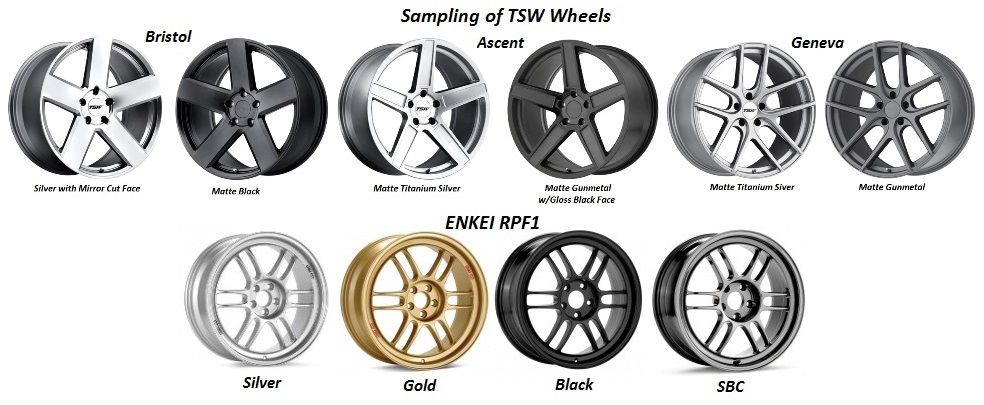
If nothing else perhaps I've given some folks food for thought.
Apologies for my prolixity.



